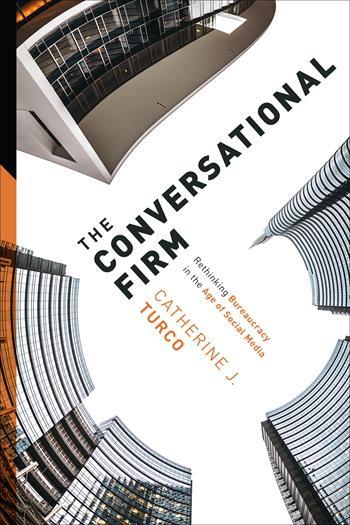A Conversational Firm for a Conversational Age
“[The Conversational Firm] will demonstrate that even if we retain certain elements of conventional Weberian bureaucracy (including a hierarchical decision-making structure), it is now quite possible to build firms in which the opinions of employees are heard, firms very much engaged in public discussion of their techniques. In this conversational age, with our new tools and platforms for voice, it is possible to build more conversational firms.” — Catherine J. Turco
This week, our featured book is The Conversational Firm: Rethinking Bureaucracy in the Age of Social Media, by Catherine J. Turco. Today, we have an excerpt from The Conversational Firm, in which Turco explains her concept of the “conversational firm,” and tells how TechCo is a perfect vehicle for her to use in exploring what a “conversational firm” can be.
A Conversational Firm for a Conversational Age
By Catherine Turco
Despite bureaucracy’s apparent indestructibility, The Conversational Firm offers hope that it is possible to pry open the iron cage if we approach things from a new angle. By following what works and what does not work about TechCo’s various attempts to transcend bureaucracy with openness—and by examining when and how conventional bureaucracy slips back in along the way—the book provides insight into the opportunities and challenges of shooting for openness as well as the nature and durability of bureaucracy. Ultimately I argue that TechCo has found its way to something quite new and different from the iron cage—a new organizational form I call the “conversational firm.”
Such an organization does not do away with all the vestiges of conventional bureaucracy. In particular, it does not become an open, democratic decision-making environment. However, it does maintain a radically more open communication environment than we have ever seen before, and this fosters a more engaged workforce and a more adaptive organization. Using multiple communication channels to promote and sustain an ongoing dialogue with its employees, the firm is able to confront the tradeoffs of openness and bureaucracy directly and to leverage the collective wisdom of its workforce to navigate them. Through its ongoing conversations, the organization finds a way to challenge the market’s—and even its own— conventional wisdom, continually iterating and improving upon both the open and bureaucratic practices it adopts as it goes.
In the process, the firm ends up deconstructing our notion of bureaucratic control quite profoundly, and this constitutes a key insight offered by this study. Weber assumed that the elements of the bureaucratic firm he identified were inextricably linked, and an assumption running through organizational theory ever since has been that a firm’s formal lines of communication and authority are essentially one and the same. Just consider how an organizational chart is still taken to be a visual mapping of both a firm’s formal lines of communication and its lines of decision-making authority. Or how the postbureaucratic rhetoric of the 1980s and 1990s assumed distributed communication would lead to distributed authority. In contrast, the conversational firm that TechCo has built shows us that it is possible to separate a firm’s communication structure from its decisionmaking structure more than we ever thought possible.
In the following pages, we will watch as TechCo distributes information and delegates voice rights both inside and outside the firm quite radically, without discarding, nor particularly destabilizing, its decision-making hierarchy. We will see that communicative empowerment and decision-making empowerment are distinct, that distributing information can be used to improve centralized decision making, that workers do not always want decision rights delegated to them, and that a stable decision-making hierarchy can support the delegation of voice. Through it all, we will learn that some bars of the iron cage can be pried open more than Weber and others ever anticipated. We will be forced to reconsider our other long-held notions of bureaucracy as well. We will see
that corporations can support spaces and platforms for individual expression; that the dysfunctions of bureaucracy (and those of openness too) need not be reflexively absorbed, but can be self-consciously discussed; that labor may demand bureaucratic elements to protect their interests; that technology can bring workers and management together in direct dialogue rather than divide the workforce and divert class conflict; and, finally, that certain myths of organizing can be cast off, and the very question of what is myth and what is efficient organizational practice can become a topic of firmwide debate and conversation.
In the end, the conversational firm that TechCo has built is not entirely postbureaucratic, nor is it radically open in every sense of the term. Just as the horizontal, distributed networks of the 1980s and 1990s failed to translate into the complete dissolution of corporate hierarchy and the end of all bureaucracy as we know it, it is unlikely we will achieve that in the social media age either. But what TechCo has achieved is still a fundamental transformation of the corporate firm and one that is possible in today’s world.
Weber believed that bureaucratic organizations necessarily suppressed conversation, both within their ranks and with the outside world, because “any intensive influence on the administration by so called ‘public opinion’” would undermine their rational, hierarchical structure. Writing some twenty years later, sociologist Robert Merton said that Weberian bureaucracy was an organizational form that “almost completely avoids public discussion of its techniques.” This book will demonstrate that even if we retain certain elements of conventional Weberian bureaucracy (including a hierarchical decision-making structure), it is now quite possible to build firms in which the opinions of employees are heard, firms very much engaged in public discussion of their techniques. In this conversational age, with our new tools and platforms for voice, it is possible to build more conversational firms.


